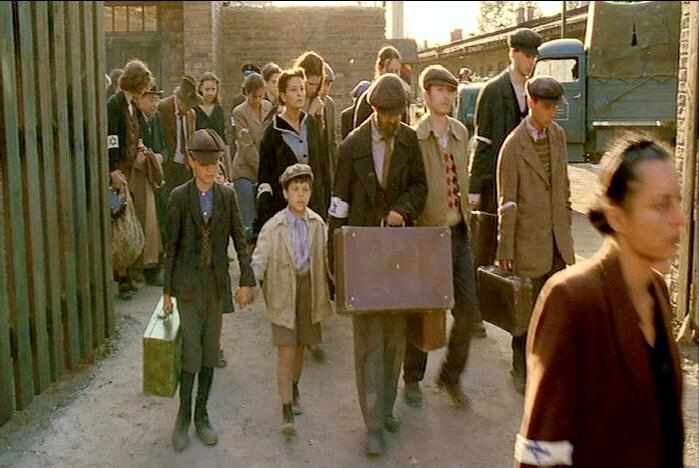
The Pianist (International, 2002)

Figure 1.--.Hans Frank, the NAZI govenor of Poland ordered all Warsaw Jews on October 3 to move to the predominately Jewish part of the city which was now called the Warsaw Ghetto. He then ordered it to walled off. Concentrting the Jews in ghettos meant that they were subsequently easily accesable for transport to death camps like Treblinka and Auschwitz. Here we see two boys entering the the Warsaw Gehtto. They wear black and brown long stockings with short trousers. Notice their typical flat caps.
|
|
"The Pianist" is an important account of the NAZI Holocaust in Poland, centering on the Warsaw Ghetto. The film is sometimes compared with another film on the same subject, "Schindler's List". The film was directed by Roman Polanski and starred Adrien Brody as Wladyslaw Szpilman, a Jewish concert pianist who miraculously survived the wholesale slaughter of the Jews in Warsaw during World War II. It is called "The Pianist" (2002). The film is unusually graphic and hard to watch because of the incredible
brutality of the NAZIs, but it was filmed with meticulous historical accuracy including the costuming. In numerous scenes we see boys dressed in the style of 1940s Warsaw. Most of the boys wear various outfits with short trousers and long stockings. Here we see two boys entering the Warsaw Ghetto when it was first established (figure 1). The Jews were told tht they were being resettled in the East. The boys wear black and brown long stockings with short trousers. Notice their typical flat caps.
Filmology
"The Pianist" is an important account of the NAZI Holocaust in Poland, centering on the Warsaw Ghetto. The film is sometimes compared with another film on the same subject, "Schindler's List". The film was directed by Roman Polanski. He now lives in France and refuses to return to Hollywood because of a scandal invovling an underage girl. The film was released by Universal (an
American company), but is probably more accurately described as an internatoinal production.
The film received the Academy Award for the best movie of 2002. In terms of the
talent contributed (writing, directing, costuming, acting, music,
filming), "The Pianist" is truly an international movie.
Setting
"The Pianist" is set in the Warsaw Ghetto duting the NAZI World War II occupation of Poland. It was shot in Poland and Germany. The Praga district of Warsaw was used for some of the filming, but many of the sets of NAZI-occupied Poland were reconstructed in a Berlin film studio,
Babelsberg. Polanski took special care to insure that the costuming and sets were authentic.
An old villa in Potsdam (a superb of Berlin) was also used in the filming.
Cast
Many actors, especually the extras, were German. The star playing Wladyslaw Szpilman was
Adrien Brody, a American.
Plot
Wladyslaw Szpilman is a Jewish concert pianist who miraculously survived the wholesale slaughter of the Jews in Warsaw during World War II.
Costuming
"The Pianist" was filmed with meticulous historical accuracy including the costuming. In numerous scenes we see boys dressed in the style of 1940s Warsaw. Most of the boys wear various outfits with short trousers and long stockings. Here we see two boys entering the Warsaw Ghetto when it was first established (figure 1). The Jews were told tht they were being resettled in the East. The boys wear black and brown long stockings with short trousers. Notice their typical flat caps.
Assessment
The film is unusually graphic and hard to watch because of the incredible
brutality of the NAZIs.
Warsaw Ghetto (1939-43)
Warsaw was the cultural center of Jewish life in Poland. About 30 percent of the city's population was Jewish. It was the largest Jewish community in Europe.Frank ordered all Warsaw Jews on October 3 to move to the predominately Jewish part of the city which was now called the Warsaw Ghetto (Otober 3). He then ordered it to walled off. The entarnces were then sealed off from the rest of the city and closely guarded by the NAZIs. Jews had previously lobed throughout the city without restruction. There had been about 0.25 million Jews in the Jewish section. Now 0.15 million more had to find acommodation there as well as for those arriving in future transports. Many within the Ghetto had to move. Jews had to abandon their property except what they could carry on bring in a hand cart. The Germans administering the Ghetto delighted in humilitaing the Jews in the initial phase of the Ghetto. Jews would be ordered to kiss the pavement or search for bits of paper in mud, all the time being beaten. [Gilbert, p. 345.] Much worse was to come. Some 500,000 Polish Jews were are forced into the Warsaw ghetto. The Warsaw Ghetto Uprising was the single most important act of defiance against the NAZI (April 1943).
Other Wardaw Ghetto Films
The Wardaw Ghetto is touched on in quite a number of films. Two other films that deal specifically with the Warsaw Ghetto during the NAZI period are "Korczak" and "Uprising". Both of these films are reviewed on HBC.
HBC

Navigate the Boys' Historical Clothing Web Site:
[Return to the Main movie page]
[Return to the Main alphabetical Pd-Pl movie page]
[Introduction]
[Activities]
[Biographies]
[Chronology]
[Clothing styles]
[Countries]
[Bibliographies]
[Contributions]
[FAQs]
[Glossaries]
[Images]
[Links]
[Registration]
[Tools]
[Boys' Clothing Home]
Created: 12:29 AM 5/27/2007
Last updated: 8:17 PM 5/28/2007



